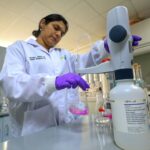Invisible Enemies: The Underestimated Risks of Chemical Contaminants
This research article investigates the underplayed risks associated with chemical contaminants in various environments.

Emphasis is placed on understanding these invisible threats, their sources and potential impacts on human health.
The analysis further explores strategies to mitigate such risks and presents case studies highlighting the real-life consequences of chemical exposure.
Key Takeaways
- Chemical contaminants originate from various sources such as industrial processes, agricultural practices, and consumer products.
- Exposure to hazardous substances can lead to serious health complications, including cancer and neurological disorders.
- Mitigation strategies involve a combination of interventions such as regulatory measures, technological innovations, public education, and improved disposal practices.
- Comprehensive chemical regulations, ongoing research efforts, and keeping pace with scientific understanding are crucial for managing chemical contamination.
Understanding Chemical Contaminants and Their Sources

Chemical contaminants, originating from a variety of sources such as industrial processes, agricultural practices, and consumer products, pose significant risks to both human health and the environment. These contaminants encompass a wide array of substances including heavy metals, organic compounds, pesticides and more. Contaminant identification is an essential step in mitigating these risks.
Industrial processes can release harmful chemicals into the air or water through waste emissions. For instance, manufacturing plants often produce byproducts like lead or mercury that can contaminate surrounding areas. Agricultural practices are also significant contributors to chemical contamination; pesticides used to protect crops can leach into groundwater or be carried away by runoff into rivers and lakes.
Consumer products represent another potential source of chemical contamination. Many items contain potentially harmful chemicals that can enter the environment during production or disposal. For example, flame retardants used in furniture can accumulate in house dust and eventually find their way into bodies of water.
Navigating this complex landscape requires comprehensive chemical regulations. This involves establishing standards for permissible levels of different pollutants in various settings (e.g., industrial emissions), imposing restrictions on certain activities (such as pesticide use), and enforcing compliance with these rules.
Effectively managing chemical contamination also demands ongoing research efforts to identify new threats and develop better strategies for risk prevention. It is crucial that regulatory policies keep pace with scientific understanding in this rapidly evolving field.
The Hidden Dangers of Chemical Contaminants

The hidden dangers associated with synthetic substances often go unnoticed, leading to potential health hazards. This underestimation can be attributed to a lack of comprehensive understanding about the nature and extent of harm these chemical contaminants can cause. In many instances, it is not until adverse effects are observed that measures are taken for their mitigation.
In light of this scenario, Contaminant Legislation plays a crucial role in controlling the release and exposure to such harmful substances. Effective legislation sets permissible limits for various contaminants in different environments, imposes penalties on violations, and mandates regular monitoring and reporting. However, it is also confronted by challenges such as enforcement difficulties and constantly evolving types of contaminants.
Meanwhile, Green Alternatives offer promising solutions towards reducing reliance on synthetic substances. These include natural substitutes for plastics like biodegradable materials made from plant starch or cellulose; organic pesticides instead of chemical ones; renewable energy sources replacing fossil fuels which cause air pollution when combusted.
However, transitioning to green alternatives requires overcoming barriers like higher costs and performance issues compared to conventional materials or methods. Therefore, research efforts should focus on improving the efficiency of green alternatives while reducing their cost.
Moreover, public education initiatives are vital in raising awareness about chemical contaminants' risks and promoting greener lifestyles.
In conclusion —while Contaminant Legislation represents an essential tool for regulating hazardous substances— embracing Green Alternatives along with increased public awareness holds key potential in addressing the hidden dangers posed by chemical contaminants.
Impact of Chemical Contaminants on Human Health

Exposure to hazardous substances, such as those often found in industrial waste or household products, can lead to serious health complications, including cancer and neurological disorders. The presence of chemical contaminants in the environment poses significant risks for human health due to their potential toxicity and bioaccumulation.
Bioaccumulation refers to the progressive accumulation of a substance within an organism over time. Contaminants may be absorbed into the body through ingestion, inhalation or dermal exposure, where they are then stored in tissues or organs. This process can result in concentrations that far exceed those found in the surrounding environment.
Most contaminants exert their harmful effects when they reach certain levels within organisms - these are known as toxicity thresholds. However, defining exact thresholds can be a complex task due to individual differences among people such as age, genetics and overall health status. In addition, certain contaminants may interact with one another inside the body and enhance each other's toxic effects.
Research shows strong links between chronic exposure to certain contaminants and various diseases like cancer, respiratory illnesses and neurodevelopmental disorders among others. Yet identifying causal relationships is difficult due to factors such as latency periods (time elapsed between exposure and disease onset), variability of exposure levels over time and space, co-exposure with other contaminant sources etc.
Mitigating the Risks of Chemical Contaminants

Mitigation strategies for reducing the hazards posed by potentially toxic substances involve a combination of interventions, including regulatory measures, technological innovations, public education, and improved disposal practices. These prevention strategies are critical in managing the risks associated with exposure to chemical contaminants.
Regulatory measures play a significant role in mitigating the risks of chemical contaminants. Contaminant legislation is an essential part of this process, setting stringent standards for pollutant levels and mandating regular monitoring and testing to ensure compliance. Such regulations compel industries to take responsibility for their emissions, preventing undue harm to both human health and the environment.
Technological innovations also contribute significantly towards minimizing potential hazards. Advances in detection technologies facilitate early identification of contaminants, allowing for prompt intervention. Furthermore, development of cleaner production processes and waste treatment systems can drastically reduce contaminant release into the ecosystem.
Public education is another crucial component of risk mitigation. By disseminating information about potential hazards and appropriate precautionary measures amongst communities at risk, it becomes possible to foster behavioral change that minimizes exposure. Additionally, awareness campaigns can advocate for safer consumer choices that drive demand for less polluting products.
Improvement in disposal practices presents another avenue for contaminant risk reduction. Proper management of waste materials allows safe containment or even elimination of harmful substances before they enter natural systems.
Case Studies: Real-Life Consequences of Chemical Exposure

Several case studies illustrate the real-life consequences of exposure to harmful substances, providing clear evidence of their impact on human health and the environment. For instance, the infamous incident in Minamata, Japan delineates a stark picture of exposure aftermath. Industrial wastewater contaminated with mercury caused severe poisoning among local residents; this event led to neurological symptoms termed as Minamata disease.
In another case from Flint, Michigan, USA, lead-contaminated drinking water resulted in an alarming rise in blood lead levels among children. The adverse effects included developmental issues and behavioural disorders that underlined the grave implications of such chemical contamination.
Analytical examination reveals that these incidents did not occur in isolation but were symptomatic of broader neglect towards contaminant legislation. In both cases, regulatory bodies failed to establish and enforce adequate safety thresholds for toxic substances. The subsequent public health crises highlighted the shortcomings within existing contaminant legislation frameworks.
Detailed-oriented research demonstrates how robust legislation can mitigate some impacts. A study focusing on pesticide exposure among agricultural workers showed significant reduction in related illnesses following stringent regulation enforcement.
Yet despite some progress made through improved legislations and policies aiming at controlling harmful substances release into the environment or monitoring their presence in food and consumer products supply chains - gaps remain evident. Enhanced measures are imperative for comprehensive protection against chemical contaminants' risks.
These examples underline a critical need for proactive measures rather than reactionary responses post-exposure aftermaths. Therefore, it is vital to continuously strengthen contaminant legislations by incorporating scientific advancements and learnings from past incidents while ensuring strict enforcement across all sectors.
Frequently Asked Questions
What Are the Common Symptoms of Exposure to Chemical Contaminants?
Common symptoms of chemical contaminants exposure may include headaches, dizziness, nausea, or skin irritation. These symptoms necessitate the application of contaminants detection techniques and implementation of emergency response strategies for effective management.
How Can Chemical Contaminants Enter the Food Chain and What Are the Potential Impacts?
Chemical contaminants infiltrate the food chain through industrial pollution, pesticide use, and improper waste disposal. Impacts include ecosystem imbalance and health hazards. Contaminants detection methods and eco-friendly alternatives are vital for mitigation strategies.
Are Certain Demographics More Vulnerable to the Impacts of Chemical Contaminants?
Geographical disparities and socioeconomic factors significantly influence vulnerability to chemical contaminants. Populations in industrial areas and lower socioeconomic statuses often face higher exposure risks, due to proximity to pollutant sources and limited access to clean resources.
Can the Damage Caused by Chemical Contaminants Be Reversed or Treated?
Contaminant remediation processes can potentially reverse or treat damages caused by chemical contaminants. However, the efficacy varies based on the contaminant type and exposure duration. Alternative solutions encompass preventative measures and regulatory policies.
What Policies Are Currently in Place to Regulate the Use and Disposal of Chemical Contaminants?
Several policies regulate chemical contaminants' use and disposal; however, policy loopholes often exist. Stricter enforcement and increased industry accountability are required to effectively manage the adverse effects of these harmful substances.
Conclusion
In conclusion, the pervasive nature of chemical contaminants and their underestimated risks demand immediate attention. To ensure public health safety, stringent regulations on chemical use need to be enforced and proper mitigation strategies should be implemented.
The detrimental effects on human health, as evidenced by multiple case studies, underscore the urgency for global action against these invisible enemies. Comprehensive research is required to fully understand the extent of damage caused by these contaminants and devise effective solutions.

This post has been generated by AI and was not reviewed by editors. This is Not legal advice. Please consult with an attorney.




